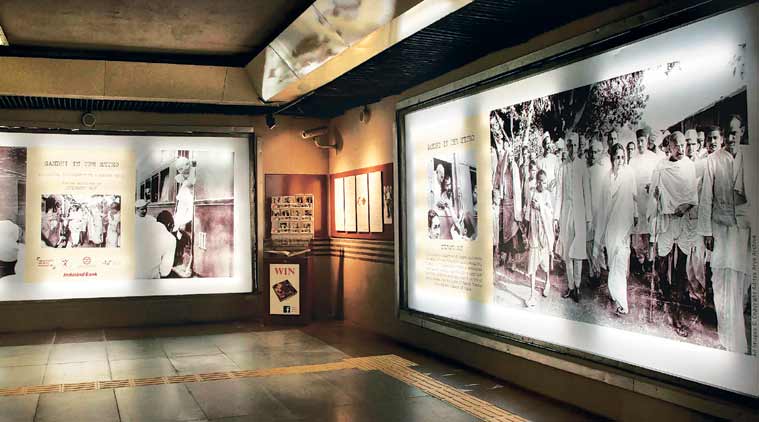Meeting Mahatma Gandhi in the Metro
Two exhibitions in the Capital celebrate the spirit of Mahatma Gandhi through archival photographs.
 The Mahatma Gandhi exhibition at Jor Bagh metro station.
The Mahatma Gandhi exhibition at Jor Bagh metro station.Dressed in his trademark khadi, Mahatma Gandhi steps down from the train onto a crowded platform. The location is difficult to ascertain, but curator Aditya Arya notes that his uncle, Kulwant Roy, had taken the photograph in the early ’40s. Campaigning across the nation, Gandhi had found a regular follower in Roy, who often trailed him. “He (Roy) often spoke of Gandhi. As a kid, I remember him telling me that after the shoot was over, Gandhi used to ask photographers for money. According to my uncle, Gandhi would say ‘now you’ll sell my photograph, so contribute to the freedom movement’. The photographers expected that and were always prepared to contribute and often joked about this exchange,” recalls Arya.
 Mahatma Gandhi stepping out of a train. (Source: Aditya Arya archive)
Mahatma Gandhi stepping out of a train. (Source: Aditya Arya archive)The Gurgaon-based photographer has now dug into his uncle’s archives to curate a two-month-long exhibition called “Gandhi in the Metro”, organised in association with the Delhi Metro Rail Corporation and India Habitat Centre. On display at Jor Bagh metro station, the prints showcase Gandhi as the leader of the masses — from his arrival at the train station to him pleading for donation for the Harijan fund in the early ’40s — and in conversation with leaders such as Jawaharlal Nehru, Sardar Vallabhbhai Patel, Maulana Azad and Muhammad Ali Jinnah. A photograph has him in Utmanzai, now Pakistan, with Khan Abdul Gaffar Khan, during his visit to the North West Frontier Province.
[related-post]
While the selection has been made from hundreds of photographs of Gandhi in the Kulwant Roy archive, Arya says effort has been made to showcase different aspects of his personality, from a mass leader to a
policy-maker. He feels the venue too would have been to Gandhi’s liking. “Gandhi only travelled in third-class compartments; he liked being a commoner and appreciated efficiency, and disliked fuss. He loved punctuality and cleanliness. I would imagine that the metro would have impressed him,” says Arya, who started archiving his uncle’s work after his death in 1984. An aerial lensman for the Royal Indian Air Force, Roy quit his job and established his own photo agency, Associated Press Photographs, in the ’40s. “He was a pioneer in his field, and photojournalism as a genre was not really known then,” says Arya.
Going a step ahead with the intention of reaching the masses, Gandhi’s fondness for postcards has also inspired the organisers to put a stall to distribute free postcards at the metro station. “We wish to engage as many people as possible,” adds Arya.



























